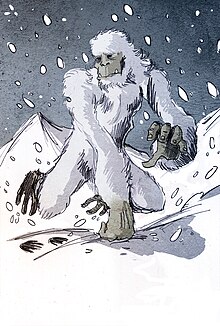yeti
The Yeti ( Tib . : གཡའ་ དྲེད g.ya 'dred ) or snowman is a two-legged, hairy mythical creature of the Himalayas . The Sherpa derived the term from Ye , Rock 'and The Animal' ago. In Tibet the Yeti is referred to as Migö (wild man) or Gang Mi (glacier man). The Lepcha have received many legends about the Yeti and call him Lomung (mountain spirit) or Chumung (snow spirit ), where they worship him as the god of the hunt and master of all red deer.
Description and interpretation
The creature is usually described as about two to three meters tall and over 200 kilograms, with footprints up to 43 centimeters in length. Lepcha and Tibetans describe it as a monkey, with an egg-shaped and pointed skull and scanty, reddish hair. The footprints in the snow were found several times and by different expeditions at an altitude of 5,000–7,000 meters and tracked over long distances.
Some zoologists and also the South Tyrolean mountaineer Reinhold Messner in his book Yeti - Legende und Demokratie take the view that the Yeti is identical to the Tibetan brown bear ( Ursus arctos pruinosus ) or Tibetan bear ( Ursus thibetanus ). In some Himalayan languages, Yeti is the word for bear. The Japanese Makoto Nebuka came to a similar conclusion in 2003 after twelve years of research in the Himalayas. For the administrative authority of the Siberian Kemerovo Oblast , the existence of the Yeti, according to its own account and media reports based on it, has meanwhile been proven. In the second week of October 2011 , the administration of the Russian province of Kemerovo announced that an international team of researchers found traces of the snow man on an expedition in the Altai Mountains . A “research group” found “footprints, his suspected sleeping place and various markings that the Yeti uses to mark his territory,” it said in a message published on the province's website. A researcher even found bits of hair in one of the footprints that could possibly have come from the Yeti. However, this authority would also like to boost tourism in the region. According to zoologists at Oxford University, the hair is horse and bear hair.
Cryptozoologists - especially Ivan T. Sanderson - and also individual anthropologists such as George A. Agogino (1921–2000) from the University of Wyoming , on the other hand, consider the assumption plausible that the Yetis are members of the relic population a still unknown hominid species. In science, however, this is a minority opinion.
Yeti scalp
In the Buddhist monastery of Khumjung in Nepal's Khumbu an alleged Yeti- can scalp the public. A second scalp has disappeared from the monastery of Pangboche (also in the Khumbu) under unknown circumstances . In 1960, Edmund Hillary and Marlin Perkins brought back an alleged yeti scalp from an expedition, which on examination turned out to be mountain goat skin.
Studies of biomaterial
A study published in mid-2014 in the journal Proceedings of the Royal Society B examined the DNA of 37 samples allegedly derived from ape-humans . Evidence of a possibly still living unknown great bear species in the Himalayas was found, but no evidence of an unknown primate species .
In 2017, another nine alleged yeti samples (bones, teeth, skin, hair and feces ) collected in the Himalayas and on the Tibetan Plateau were subjected to molecular biology testing at the University of Buffalo . The sample from the Messner Mountain Museum came from a dog, the other eight samples could be assigned to the Asiatic black bear , the Himalayan brown bear and the Tibetan brown bear.
literature
- Reinhold Messner: Yeti - legend and reality . S. Fischer, Frankfurt 1998, ISBN 3-596-14737-9 .
- Harald Gebhardt, Mario Ludwig: Of dragons, yetis and vampires - on the trail of mythical animals . BLV-Verlag, Munich 2005, ISBN 3-405-16679-9 .
- Blanche C. Olschak, Augusto Gansser, Emil M. Bührer: Himalaya - growing mountains, living myths, wandering people. vgs, Cologne 1991, ISBN 3-8025-2218-4 .
Movies
- Yeti the Snowman , adventure film (1957)
- Yeti: The Snow Monster , horror film (2008)
- Yeti: The Secret of Glacier Peak , horror film (2013)
- Smallfoot: An Icy Adventure , Animated Film (2018)
See also
Individual evidence
- ↑ Olschak, Gansser, Gruschke, Bührer, p. 254 (see lit.)
- ↑ NetZeitung ( Memento from January 16, 2014 in the Internet Archive ) from September 20, 2003
- ↑ "DNA analysis: hair samples not from a Russian Yeti but from an American black bear"
- ↑ George A. Agogino in: Ivan T. Sanderson: Abominable Snowmen: Legend Come to Life, The Story of Sub-Humans on Five Continents from the Early Ice Age Until Today (preface). Philadelphia / New York 1961.
- ^ BC Sykes, RA Mullis, C. Hagenmuller, TW Melton, M. Sartori: Genetic analysis of hair samples attributed to yeti, bigfoot and other anomalous primates. In: Proceedings of the Royal Society B: Biological Sciences. 281, 2014, p. 20140161, doi : 10.1098 / rspb.2014.0161 .
- ↑ Charlotte Hsu: Abominable Snowman? Nope. Study ties DNA samples from purported Yetis to Asian bears , University of Buffalo (News Center), November 28, 2017. Retrieved November 29, 2017.
Web links
- Rebecca Onion: The American Government's Advice for Yeti Hunters, 1959. In: The Vault. Slate Magazine, February 26, 2013, online

